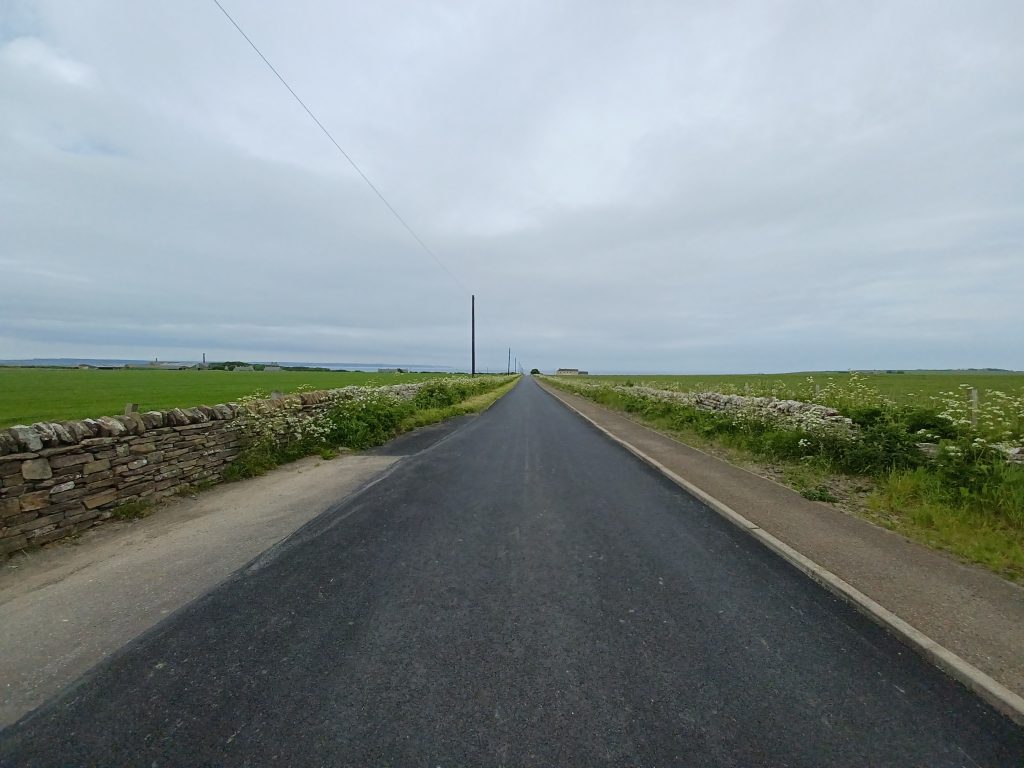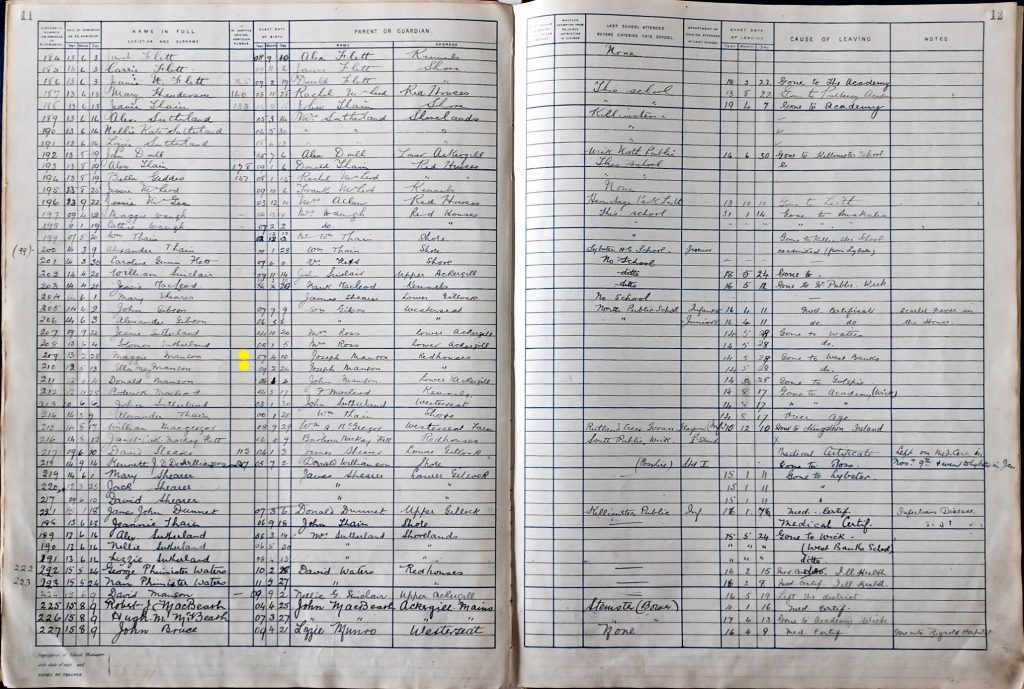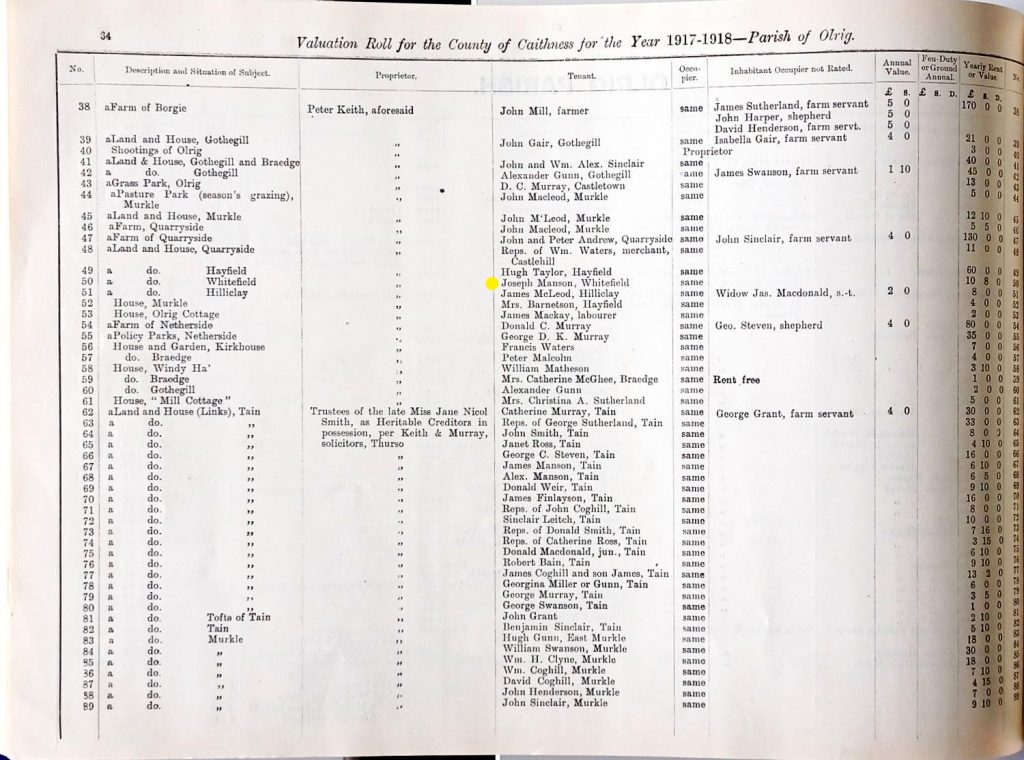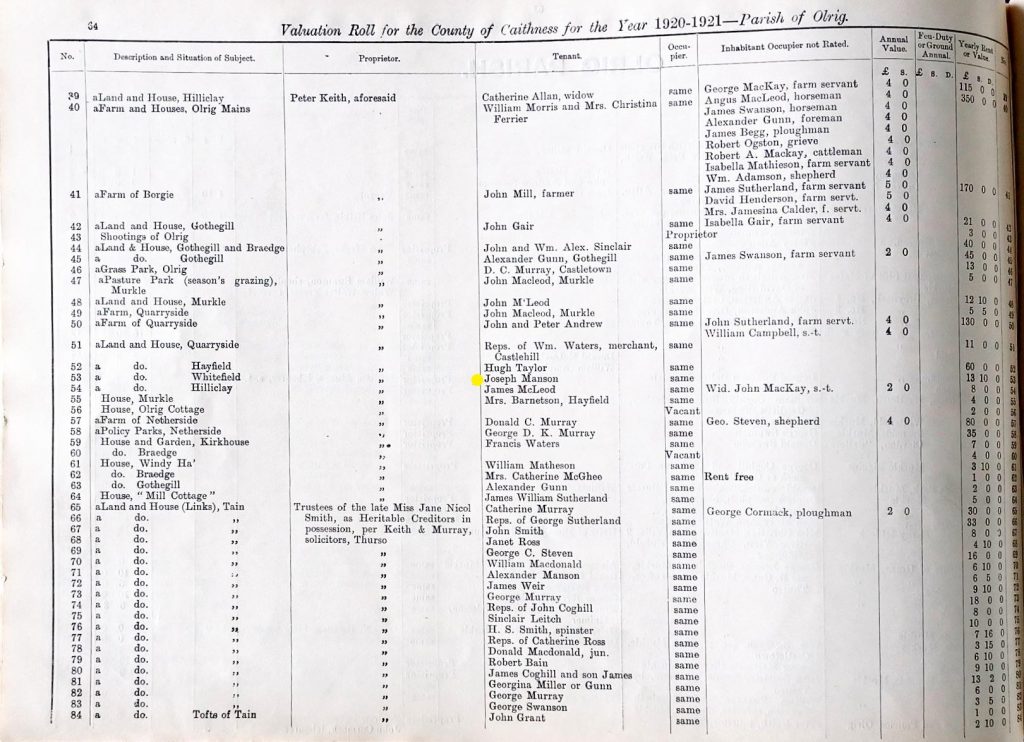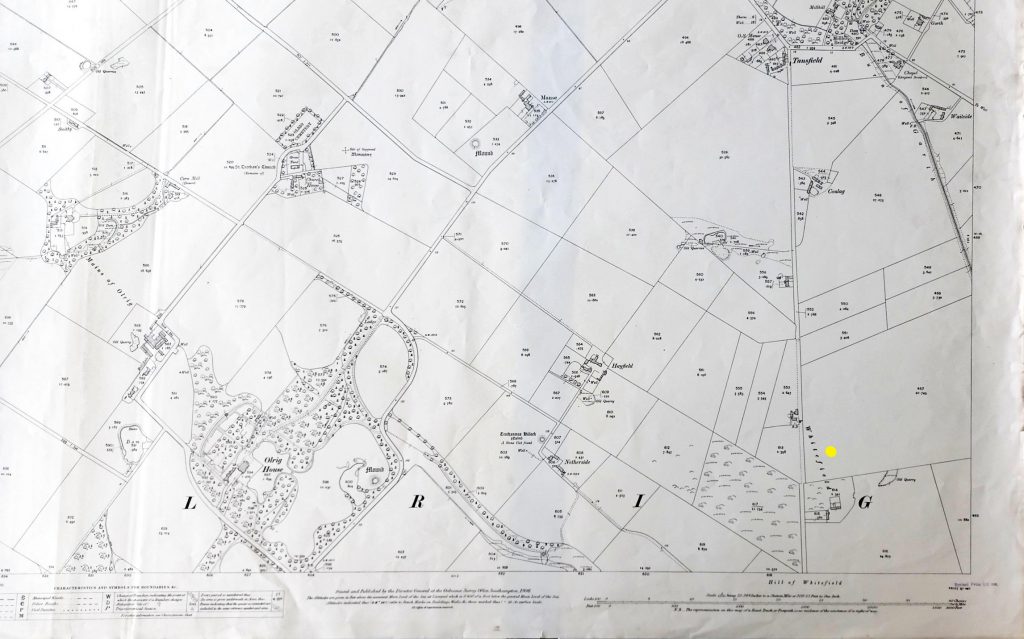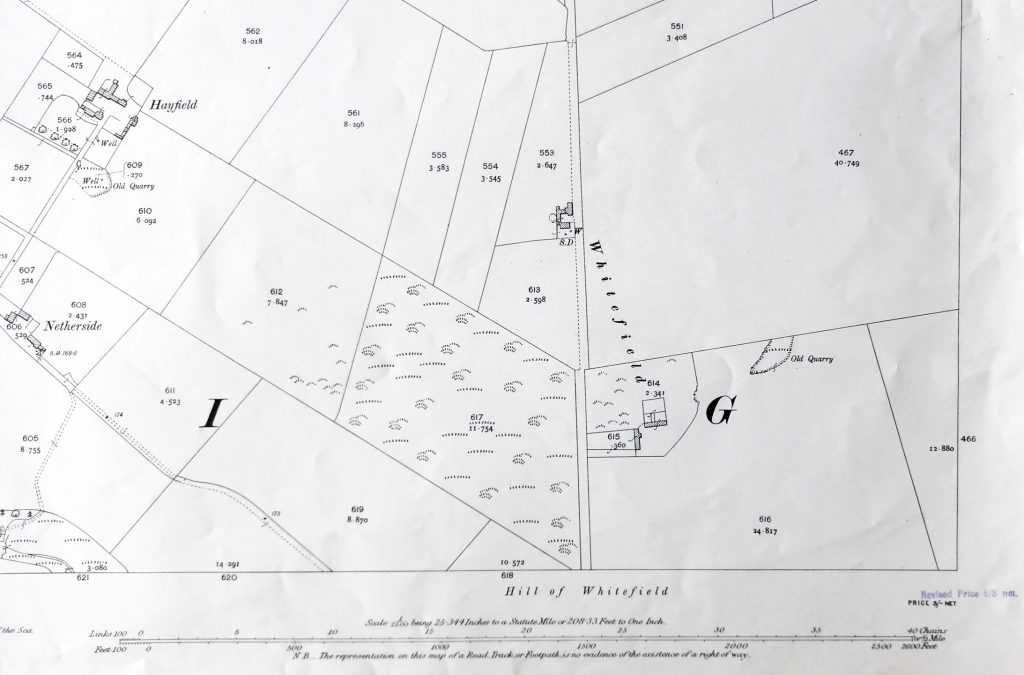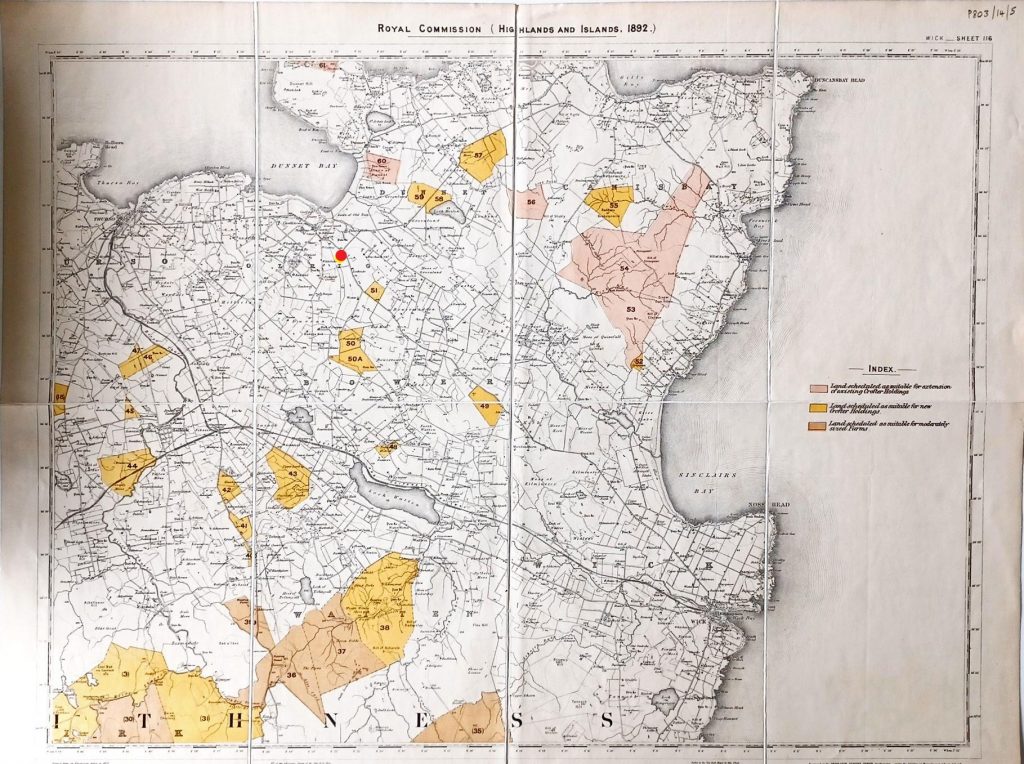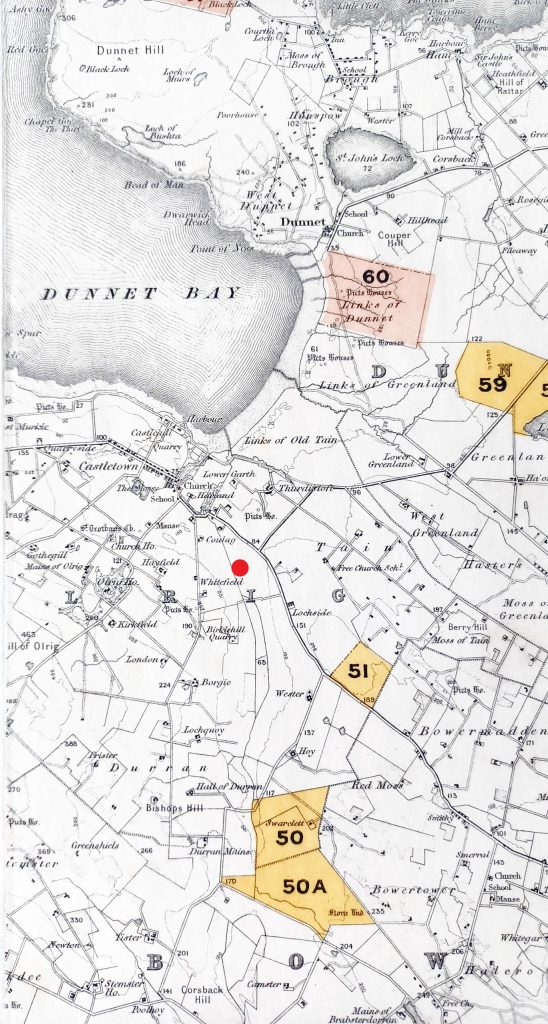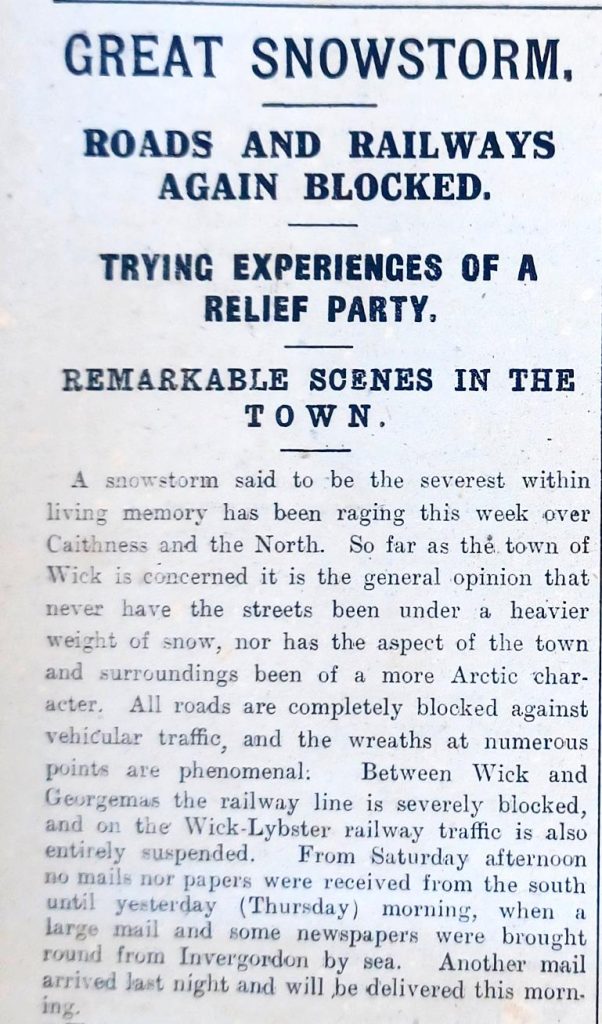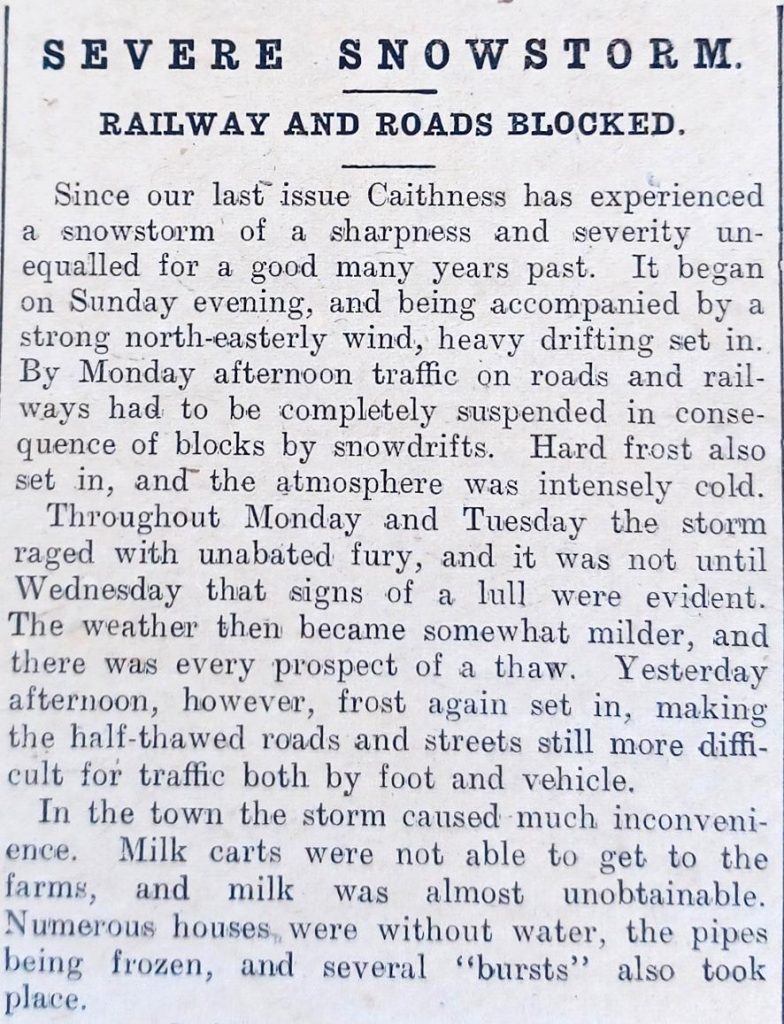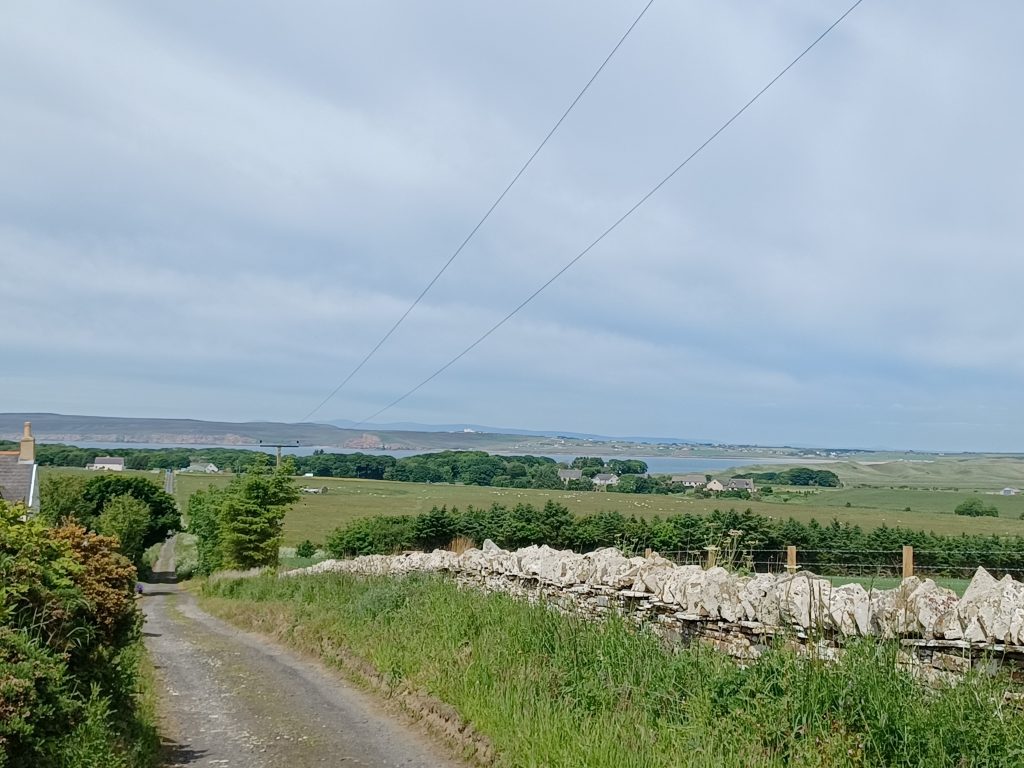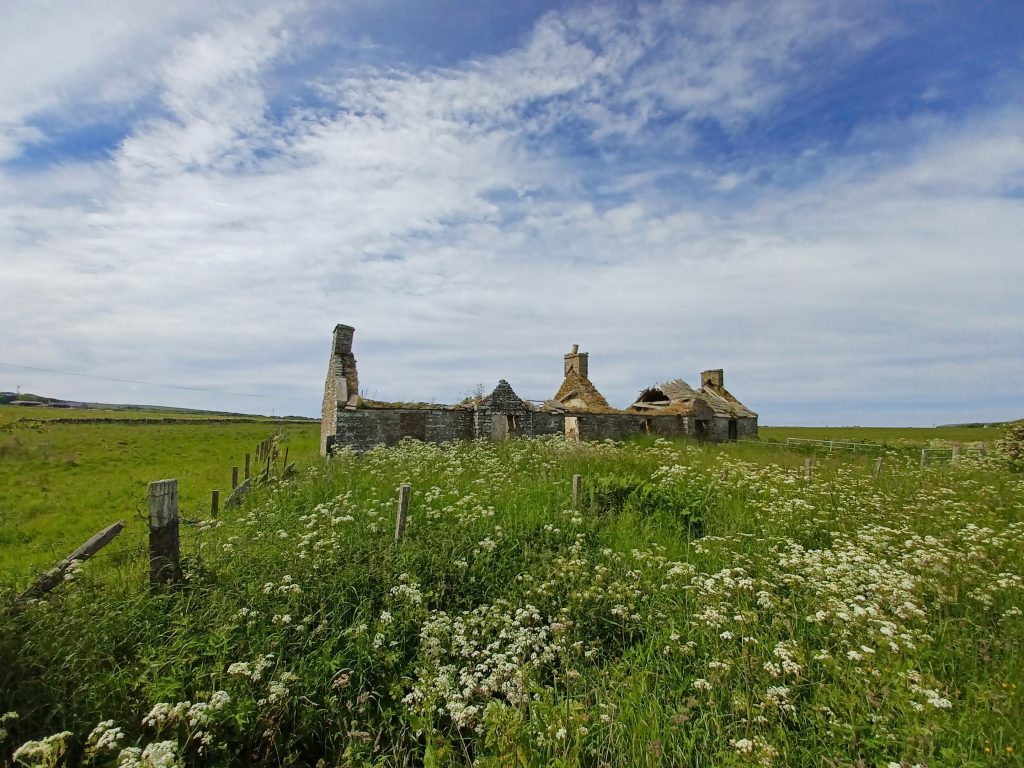
A Brief Introduction
Travelling throughout Caithness it is hard to miss the abundance of ruined grey stone buildings stood defiantly within the landscape. From the roadside you will see many such roofless structures and on a closer walk around the countryside the foundations of others almost completely demolished.
These old croft houses are perhaps the last monumental reminders of a way of life that has long since ceased to exist on any discernible scale. On coming across them it is hard not to begin imagining the myriad lives that played out within the thick walls, the small areas of arable and pastoral land that must have surrounded them, the adults and children working and living within a world at once alien to our technological present and suddenly idyllic on account of its simpler, if harsher, reality. They represent what French historian Pierre Nora calls milieux de mémoire, ‘real environments of memory’.
In this edition of Stories From The Archive we’d like to share a tale from life on the croft, given first hand by Ella Campbell. Moreover, we’ll explore the significance that individual memories such as Ella’s play within the broader realm of collective remembrance and history, along with the importance of preserving such stories within the archives.
Through attributing stories such as Ella’s to the ruins of old crofts we are, in Nora’s words, changing them from milieux de mémoire, ‘real environments of memory’, to lieux de mémoire, ‘sites of memory’; places where memory ‘crystallises and secretes itself’, venerated traces ‘of that which has already happened’.[1] In essence we are changing them from ruin to monument.
This transformation, however, is not without apprehension. You would be unlikely to have missed the increasing controversy surrounding monuments in recent years and so we wish to make our intentions clear. In remembering Ella’s story we are not pursuing the construction of contention, but instead looking to attribute a deeper context and understanding upon what would otherwise be uninterpreted ruins. We wish to explore and celebrate the animus loci, the very soul, of her croft and way of life there; to confirm through research and remembrance one specific ‘place-story’ amongst the innumerable untold.
Author: Ella Campbell
Ella Campbell was born in 1909 in Auckengill, Caithness. Ella and her family remained in Caithness, moving around crofts and farms, until she moved to Stirling in the 1950s. The narrative is an account of her life in Caithness and thereafter and would have been somewhat typical for families living on crofts in the county in the first half of the twentieth century.
Provenance: Private Deposit
Ella’s collection was deposited to the Caithness Archives in 1999 and contains both typed pages of her recollections and handwritten letters between herself and the Caithness Archivist further describing her life and adding additional context to her experiences.
The catalogue and descriptions of Ella’s collection along with the holdings of all four repositories within the Highland Archive Service may be searched online at:
https://archives.highlifehighland.com/calmview/default.aspx.
Any research enquiries may also be sent to the Archive staff via:
Format: Personal Recollections
Ella’s recollections are of course subjective, they represent one voice amidst many who lived and worked within the crofting communities of Caithness in the first half of the twentieth century. However, her individual memories are part of a larger story, a piece of the overall collective memory. Many recordings describing life in Caithness and photographs can be found on the Am Baile website along with other oral history testimony held by the Caithness Archives: https://www.ambaile.org.uk/ . Try searching for ‘croft Caithness’, the results are fascinating.
Ella’s story, told in written prose, is also part of the wider universe of community histories and community archives. Preservation of such histories is not only widespread but also diverse. They may be held or created through institutional and local authority archives (such as Nucleus), local heritage initiatives and groups, oral history projects, community history projects and community memory projects to name a few.
Ella’s story is one of countless that make up a huge, combined archive, spread across numerous repositories, documenting historical recollection from across the UK. This resource is important firstly in representing the histories of the groups it documents. However, it is also important in the wider contribution it makes to all of our stories which become reflected within an inclusive national heritage, one determined to represent and serve everyone.
In exploring Ella’s story we must bear in mind the wider context of her memories and how they make us look twice at those old ruined buildings; remember the importance of her telling her own story and giving both empowerment and posterity to her crofting community; and finally the positive consequences of her lending her own voice to the collective whole, adding a small but substantial interlacing to the intricate tapestry of the past.
A Tale of Life on the Croft
Beginnings in Caithness
Ella’s mother Elizabeth Bruce married her first husband James Begg in 1901. James developed tuberculosis due to working in a cold damp house, and so it was decided that they would move to Caithness and stay with his parents Alex and Eliza Begg of Milton, Auckengill. They hoped the climate might help his condition, however, he passed away only eleven months after they were married. Their baby daughter Ina was born a fortnight later on the 25th May 1902.
Ella explains that:
‘Mother then took a house at Red Houses, Ackergill where she took in lodgers to help support her and her daughter. In 1906 she met and married our father Joseph Manson and they has a daughter Margaret. When she was only a year and ten months old, I Ella was born. The local school was situated just across the road from our house and the teacher, who was a friend, took her lunch with us.’
The picture below shows Red Houses, Ackergill today where Ella lived and went to school.
Also reproduced below are entries from the school admission register for Ackergill School showing attendance by Ella and Margaret. Their names have been marked with two yellow dots. We can see Maggie Manson was admitted 28/02/1913 and Ella Manson 13/05/1912. It also shows their father as Joseph Manson and their address as Red Houses.
The lines read:
| Admission No. | Date of Admission | Name in Full | Date of Birth | Parent or Guardian | Address |
| 209 | 28/2/1913 | Maggie Manson | 10/04/1907 | Joseph Manson | Redhouses |
| 210 | 13/06/1912 | Ella May Manson | 24/02/1909 | Joseph Manson | Redhouses |
Ella is unsure exactly when but can remember her mother opening a shop, perhaps a precursor to her own industrious nature. She recalls that:
‘As was often the case in those days, she eventually had to give it up. She was not good at saying no when customers asked for credit. She sold the shop to a neighbour who lived across a field and, as it was made of wood and could be moved on rollers, part of the dyke had to be taken down to let the shop through on both sides of the field.’
Soon thereafter the family grew again with the arrival of two more sisters, Rena and Helen, and a brother Joe. Jobs had become scarce, owing to the impacts of World War One, and so Ella’s mother decided the family should:
‘move to a croft with perhaps a cow, a horse and some hens. We arrived at the croft Whitefield, Castletown on term day 28th May, 1917.’
Whitefield & Childhood
The family of seven arrived at the croft in 1917 and the valuation rolls for Olrig Parish 1917-1918 and 1920-21, reproduced below, show her father Joseph Manson as Tenant at Whitefield. His name has been marked with a yellow dot. His landlord was the proprietor and solicitor Peter Keith of Thurso. Note the increase in rent from £10 8s to £13 10s.
The area of Whitefield is just to the south of Castletown at the turn for Tansfield. Both the Ordinance Survey Map and Royal Commission maps of crofter holdings showing Whitefield are reproduced below. It has been marked with a yellow or red dot.
Cultivation & Diet
The soil on the croft was poor meaning that only black oats could be sown. One neighbour remarked that ‘even the rabbits had to go on their knees to eat it’. In Caithness oats were always referred to as corn and you can see this reflected in Ella’s remembrances.[2]
Alongside a cow, a heifer calf and some hens the family began planting tatties and turnips. Ella helped spread dung in the rows, carry water up the steep hill to Whitefield (only by the 1960s had many rural houses acquired a mains water supply), and pull thin yellow weeds known as ‘scolag’. Grant explains that:
As part of a regular rotation, these crops helped to clean the land, which under continuous cereal crops was infested with weeds, and also improved its fertility… They, especially the turnips, provided the much needed winter feeding for the livestock.[3]
The winter also saw the threshing of the oats (or corn). Ella’s work included driving the horse round in a circle, ‘pulling a shaft to drive the mill to thresh the corn, then the corn had to go through the fanners, a separate machine to clean the corn’. The horse was important as a beast of burden until it was largely replaced by small tractors from the end of the 1940s. Ella explains the process further:
‘The corn was poured in at the top and father had to turn a handle which turned the wheel to make it go. I was at the other side, where there were two small doors, which had sliding shutters to open and close the doors. I had to watch the corn coming into a bushel and close the door when it was full, so that father could come up and empty it (our father was deaf). The bushel was a measure of grain. It was wide like a large barrel but only about 24 inches wide (more or less). When full, piled high, it was put on a large clean surface and a roller was run over it, leaving the corn level. That was a bushel and how grain was sold.’
In summer the cattle were herded on a road going up to a local quarry. Ella explains that within a few years the quarry was no longer used to extract flagstones and was only used to wash the sheep before clipping. Also during the summer her mother would be busy making butter to sell:
‘Mother got a small glass churn, similar to a confectionery jar but wider and not so tall. It had an egg switch fixed in the lid and when she turned, it made the butter, which was sold and margarine bought for our own use. She also used some of the eggs mixed with flour, fried in a large frying pan and cut into eight pieces. I’ve tried to make it but never got it right.’
Up until at least the 1930s crofters tended to be as a self-sufficient as possible, buying only a few necessities such as sugar, salt and flour. The main diet consisted of oats, potatoes and turnips, with lesser amounts of vegetables such as cabbage, carrots and leeks being grown. The cow produced milk for a range of dairy products, and pigs and poultry were reared for home consumption. There was very little in the way of fruit except perhaps a few strawberries. Ella mentions a ‘lovely drink’ known as ‘sowans’ which was made from the husks of corn or ‘shellings’. Some oatmeal was added to the husks, put in a tub with water and occasionally stirred. It would be taken to the fields on hot days as ‘a good thirst quencher’. Although mostly self-sufficient rural areas were also served by mobile shops, called the vans. It was also normal to buy in a barrel of salt herring to last over the winter.
Holidays & Snowstorms
Ella and her siblings were often sent on holiday to stay with Ina’s uncle and aunt in Auckengill, presumably the same Alex and Eliza Begg of Milton. She recalls that they would be:
‘put on the bus at Castletown and arrived at Wick where Ina met us. When the bus for John O’Groats was due to leave Ina was to put us in the charge of the driver to let us off at the Post Office at Auckengill. One time Rena and I were going and as Ina couldn’t meet us a friend did. She put us on the John O’Groat bus but didn’t tell the driver (it was a different driver) to let us off at Auckengill. Eventually I asked if we were near Auckengill to be told we were past it and were at Canisbay. The driver took us to his mother who kept us that night and we went on the bus to Auckengill the next day’.
Whilst there Ella was struck by how poor the crofts were. She explains that they only kept cows which needed to be tethered and constantly moved to different areas of grass. As was very common these crofters also worked as part time fishermen to supplement their living. She remembers going down to watch the catch come in and how the fish was divided; equal shares with one extra for the boat owner.
The fishermen also made their own ropes:
‘They had a broad board, one end of which rested on an axle with a wheel on each side. It had an upright board fixed on it with three hooks in a triangle at the top. On the other end was placed a very heavy stone. The other board was fixed upright in the ground with one hook, which was fixed so as to turn when a handle was turned. They bought balls of binder twine and this was just so many strands according to the thickness of rope required. When turned the strands were twisted and made into ropes. The heavy stone kept it from tilting, but as the rope was made the one on the wheels came nearer the other board.’
As well as holidays Ella remembers a severe snowstorm:
‘ I don’t remember the year, but there was a great snowstorm and the road was blocked for six weeks, before the side roads were cleared. The bull sales were at the end of January and most years the side roads had to be cleared to get the bulls to sale.’
Ella may be referring to the ‘Great Freeze’ of 1918 reported below in the John O’Groat Journal.
It must have been a bone-chilling experience within a croft house with only a peat fire for warmth and the added worries of livestock and water. Ella remembers cutting peats:
‘In spring we had to cut peats, which was the ground under the turf, where woods had been at one time. When cut, dripping wet, we had to take them on graips and spread them on the ground so they would dry enough to be able to take them and set them in bunches on end. When thoroughly dry, they were carted out and built in long stacks for burning in our fires.’
Fires would have been a necessity with such extreme weather no stranger in Caithness. One of our other editions focused on the severe weather of 1955 and Operation Snowdrop. You can read about it here.
School & Employment
Even amidst the harsh weather and hard work of the croft Ella and her sister Margaret continued to attend school, now at Murkle. Ella tells of Spring when she and her sister Ina:
‘pulled turnips from 7.00am until 8.00am then rushed home to wash, get food, and I would get off to school and she would get off to work.’
Later Ella was given three months off school to allow her sister Margaret to concentrate on her exams. Margaret would go on to become a teacher.
Ella, however, never went back to school but in 1924 she hatched ninety-three chickens at the age of fourteen. She then decided she would get a job and found one ‘looking after a cow, heifer, hens and sometimes the sheep with some housework as well’. Her employer taught her to drive and to use a gun. These skills added to her sterling and ever growing knowledge of crofting life and were to pay her diligence through marriage and motherhood.
Crofting life & Adulthood
Marriage & Motherhood
By 1929 Ella had met and married Alex Campbell. Their son George was born on the 30th May at Whitefield whilst Alex was working as a horseman on a large farm at Gerston, Halkirk. Ella later joined him at Gerston, however, they soon returned to Whitefield due to his ill health.
Ella’s first daughter died within a few hours of being born and was the first of several tragic losses she suffered. There seems not only a harshness in the weather but in their very existence, in the reliance on good fortune for steady sustenance and life both in the fields and within the crofts themselves.
They then found another job at West Canisbay, Alex as a cattleman, and Ella thinning out cabbages in the large fields for 3d an hour, 2/3 (thirteen pence) for a nine hour day, from 0700-1100 and 1300-1800.
By 1940 Ella and Alex had two more sons and daughters – Alasdair, Bruce, Isabel and Jenny. Ella’s own mother and father were by this time taking ill and they decided again to move back to Whitefield in 1941. Whilst they had been away her father had made many improvements to the croft:
‘father had been given the material to extend the house which now has three bedrooms upstairs, two rooms and a small bedroom downstairs and a milkhouse had been built into the end of the scullery. The scullery had cold water from a fifteen thousand gallon tank father had bought…Father also built a long building for the henhouse… also a pighouse and he made a trough inside the outer wall.’
Ella’s mother Elizabeth passed away in 1947.
Ella’s Croft
Thereafter, Ella’s sister bought her an incubator and she arranged to get eggs and set up a meeting with the poultry adviser. She was advised to get rid of the hens and start a poultry station under the Board of Agriculture, which she did:
‘I started out with three incubators and finished up with five, with one hundred and fifty eggs in each. I used my mother’s henhouse for the incubators and gradually got henhouses out in the fields. I decided to go in for good layers such as Rhode Island Reds and crossed them with White Leghorns.’
The eggs had to be turned by hand twice a day and marked (hens often turn the eggs with their wings when sitting on them).
They also decided to keep a sow (female pig) and when she was farrowing (giving birth) Ella was the only one there:
‘I didn’t know much about it but the sty had to have a beam fixed right round high enough for the piglets to get under. A pig doesn’t lie down, she just flops and the piglets get under the beam. One person wrote in a paper saying that when the piglets were born, to put them in a cardboard box until they were all born and let them all out of the box together. It didn’t say how difficult that would be as they had their cords all tangled up and I had to cut each one out. I never told anyone what I had to do until a long time later.’
Whitefield now had an engine to drive the mill instead of the horse Ella drove as a child. They had added ten acre allotments to the croft as well and they needed the engine to pump water from the burn, up the steep hill, through a long hose, to water the cattle, sheep and two henhouses. This was done twice a day with the help of a ‘very clever collie’ named Fly:
‘after a day or two, I didn’t need to tell her we were taking the cattle for a drink. When I opened the gate she had the cattle gathered. On the way down, she guarded each gap where they could have turned into and, when I opened the gate at the allotments, the cattle made straight for the water. Fly had gone and gathered up the sheep for me to check, and then I attended to the hens. When she saw that the cattle had finished drinking, she had them ready for home.’
Ella’s husband Alex was often away all week on contracted agricultural work leaving her to cope with all the crofting responsibilities including those of lambing season (they had twenty ewes). She laments, ‘he never seemed to be at home when things went wrong’ and that she could not have kept going without the boys helping so much.
Like her mother, Ella continued to make butter with the help of a milk separator, ‘with having so much to do I tried to make things as easy for myself as I could’.
Weather, Luck & Farewells
‘In 1952 a terrible gale struck and the family were all at work. Part of the roof was blown off and when I went to see what the other buildings were like, the roof of the tractor shed was being lifted off completely. I was afraid that the whole roof would go over the byre and break the upstairs window. I rushed in and shouted to the girls to take their clothes and come downstairs and dress. The wind got worse and the scullery door burst open and when I went to try and close it, I found that the lock was off the jamb. I got a jumper (a long piece of iron like a broom but with an end like a claw hammer) and jammed the door with that. The roof of the tractor shed had fallen over a wall and into the midden and so that was safe. We had half a hanger for our other implements sunk into concrete and it was blown out as if it had been in cheese, also some of my henhouses were destroyed. We later heard that the wind was 120 miles per hour.’
Ella’s luck did not improve thereafter. In the February of that year her father died and swine fever was diagnosed amongst her pigs.
The following year she had ‘a disastrous season’ when a dog got in amongst her three henhouses wreaking havoc and killing many of the animals or scaring them off. She couldn’t sell her eggs for hatching or take orders for chickens as the eggs might be infertile.
By this time Ella explains ‘I had big bills for feeding every month as we were the only croft with big farms all around’. Alex’s wages paid for his keep whilst working away from home with little left over for profit. She wrote to the Board of Agriculture and told them she was giving up. She advertised for a job in the Scottish Farmer and found one in Fife.
Ella bade farewell to Caithness and left her crofting existence due to the changing economic and industrial circumstances of the modern capitalist world. It wasn’t until 1968 that the Crofters Commission proposed crofters be given full rights of ownership to their crofts.[4] Up until 1955 the importance of crofting is shown by the fact that 51% of the holdings in Caithness were of less than 6 hectares (15 acres), only a slight decrease from the total in 1896.[5] By 1968 the total number of holdings in the county had decreased from 2,439 to 1,612, showing a substantial decrease in the number of very small holdings and a consequent increase in the larger-sized farms.[6]
This is not in any way an attempt to conjure ideas of removal or the implicit word Clearance. Paul Basu has explained that there is often a tendency to associate the Clearance narrative with every crofting ruin in the Highlands. In telling Ella’s story we hope to avoid fabricating what he calls ‘unintentional monuments’ of this narrative and instead present a somewhat typical story of Caithness crofting life in the early twentieth century.[7]
Like many others Ella moved south for work. Financial security was impossible in the face of such changeable circumstances; be it weather, health, wealth, or the uncontrollable inconvenience of the unforeseeable (such as dogs in henhouses).
Her Mother’s Daughter
Ella’s job in Fife was looking after poultry. In October 1954 she got soaked whilst out in the fields ‘took ill and collapsed on a Tuesday’. Her pay was stopped immediately and she was told to vacate her house by the Saturday.
Ella was taken to Perth Royal Infirmary then Bridge of Earn Hospital where, despite her doctors fears, she began to recover. Her brother Joe and sister-in-law Betty had taken in her girls.
After recovering she went to stay with her youngest sister Helen and later found a job cooking at Orchard House, Stirling.
In retirement Ella began embroidering and spent some time in and out of hospital. To thank many of the people who had helped her, including nurses, doctors, ambulance drivers and even MPs, she began making and embroidering tray cloths with people’s initials on them; ‘to date, I have embroidered one hundred and seventy four of them’.
Ella ends her recollections by reminiscing about her mother, Elizabeth, a figure who seemed to loom large in her life and in her nature and character too:
‘My mother was a great help to me and also influenced my life in lots of ways. She had rheumatics but managed to peel a pail of potatoes every night and you could pick up the skins from the pailful in two hands. I have never yet seen anyone who could take such thin skins from potatoes. She prepared vegetables, mended and patched, as well as looking after the girls as I couldn’t take them with me while looking after the animals. But most of all the faith she displayed was an example to us all.’
Collective Memory and the Archive
Ella’s final words to the reader are as follows:
‘I gave the ingredients and my friend made the cake. I have to explain, the ingredients were what I did, the story was the cake.’
Commemoration is very often the primary indicator of an event’s importance and in order to effectively preserve the past as a living thing, we require ‘cognitive bridges’ that connect the past and the present. Put another way, Barry Schwartz has stated that:
Historical events and persons are unobservable and the only way one can know them is through memories of their influence on contemporaries.[7]
Ella provides these memories, the ‘ingredients’ as she calls them.
What does all this mean for the recollections of Ella Campbell? It means they are a powerful and insightful part of the collective memory and historical record pertaining to a previous way of life, both in Caithness and further afield. They are also a valued source of context and details, complimenting official records including School Admission Registers and Valuation Rolls.
Ella provides an intrinsic ‘cognitive bridge’ between the ruins at the side of the road and her words preserved at Nucleus; adding both to the individual memory of those passing by and the overall collective memory of Caithness.
Afterword
In a letter to the then Caithness Archivist, Ella explained that:
‘The croft we lived in was Whitefield. We turned up at Tansfield… you could see right over the plantation to the crofts in Dunnet, the crofts were like patchwork.’
We decided to go an see the view for ourselves. It will, inevitably, be quite different from what Ella remembers. Instead of a patchwork of crofts there is now a patchwork of modern houses. However, we will now think quite differently when passing by Whitefield or, indeed, any time we see an old croft house by the side of the road. We will think of Ella and her story and how it not only compliments the historical record but also the current collective memory of everyone who reads her tale from a life on the croft. In essence this is not only a story from the archive but an ongoing story we all tell and will continue to extract and add to. The importance of the archive is out beyond the repository walls, a part of the lives of all who encounter it.
‘We are affected strangely by any place from which the tide of life has ebbed’
– Neil M. Gunn[8]
Read more Stories From The Archive
References
[1] Paul Basu, Highland Homecomings (Routledge 2007), p. 151
[2] https://www.ambaile.org.uk/search/?searchQuery=Croft+Caithness
[3] I. F. Grant, Highland Folk Ways (Birlinn Origin, 2018), p. 112.
[4] James Hunter, The Making of the Crofting Community, 3rd ed. (Birlinn, 2010), p. 298.
[5] The Caithness Book, ed. Donald Omand (Highland Printers Ltd, 1972), pp. 184-185
[6] Ibid
[7] Barry Schwartz, ‘Rethinking the concept of collective memory’ in Routledge International Handbook of Memory Studies, eds. A. Tota and T. Hagen (Routledge, 2016), p. 15.
[8] Neil M. Gunn, ‘Caithness and Sutherland’, in A. McCleery, ed., Landscape and Light: Essays by Neil M. Gunn (Aberdeen University Press, 1987), p. 32.
